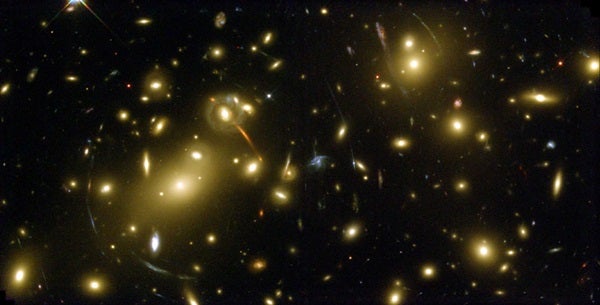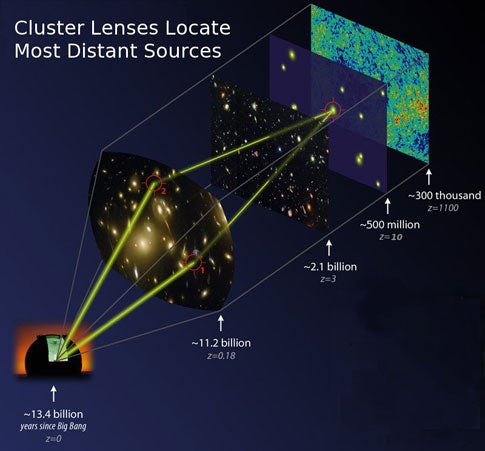Using natural “gravitational lenses,” an international team of astronomers claim to have found traces of the most distant galaxies yet seen. Light we see from them today left more than 13 billion years ago, when the universe was just 500 million years old.
Team leader Richard Ellis, the Steele family professor of astronomy at the California Institute of Technology, presented images of these faint and distant objects in his talk July 11 at a conference, titled “From IRAS to Herschel and Planck,” at the Geological Society in London. The meeting is being held to celebrate the 65th birthday of Royal Astronomical Society President Professor Michael Rowan-Robinson.
“Gravitational lensing is the magnification of distant sources by foreground structures,” Ellis explained. “By looking through carefully-selected clusters, we have located six star-forming galaxies seen at unprecedented distances, corresponding to a time when the universe was only 500 million years old, or less than four percent of its present age.”
When the universe was 300,000 years old, it entered a period when no stars were shining. Cosmologists refer to this phase of cosmic history as the Dark Ages. Pinpointing the moment of “cosmic dawn,” when the first stars and galaxies began to shine and the Dark Ages ended, is a major observational quest. It is motivation for building future powerful telescopes, such as Caltech’s Thirty Meter Telescope, and the space-borne James Webb Telescope.
The new survey is the culmination of three years’ painstaking observations, and Caltech graduate student Dan Stark’s thesis. “Using Keck II, we have detected six faint star-forming galaxies whose signal have been boosted about 20 times by the magnifying effect of a foreground cluster. That we should find so many distant galaxies in our small survey area suggests they are very numerous indeed. We estimate the combined radiation output of this population could be sufficient to break apart (ionize) the hydrogen atoms in space at that time, thereby ending the Dark Ages,” Stark said.
Proving each of the six objects’ distances is difficult, even with the most powerful instruments. “As with all work at the frontiers, skeptics may wish to see further proof that the objects we are detecting with Keck are really so distant,” confessed Ellis. However, in addition to numerous checks the team has made following their initial discovery a year ago, Ellis and Stark point to supporting evidence from galaxies containing old stars seen when the universe was just a bit older.
“We can infer the universe had a lot of star formation at these early times from Spitzer Space Telescope measurements of larger galaxies seen when the universe was about 300 to 500 million years older,” explained Stark. “These galaxies show the tell-tale sign of old stars. To produce these old stars requires significant earlier activity, most likely in the fainter star-forming galaxies we have now seen.”











